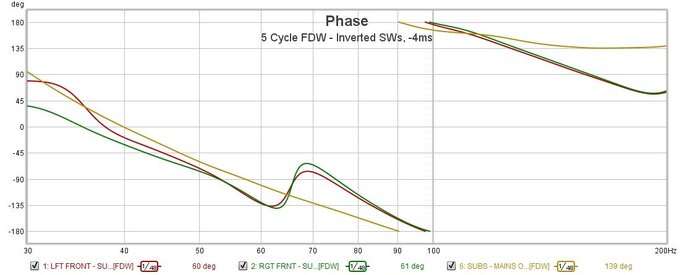jtalden
Senior Member
More
- Preamp, Processor or Receiver
- Marantz AV7705 Pre/Pro
- Main Amp
- VTV 6 chnl NC252MP P-amp x 2
- Additional Amp
- Behringer DCX2496 x 2
- Universal / Blu-ray / CD Player
- OPPO BDP-103 Universal Player
- Front Speakers
- DIY SEAS H1456/H1212 Spkr x 5
- Subwoofers
- DIY JBL 2235H 15" SW x 2
- Screen
- Da-Lite Da-Snap 39105V - 92"
- Video Display Device
- JVC DLA-X790R
These are excellent measurements. SPL, XO delay timing and overall performance all looks good and similar to the reference setup. I am curious to know if you hear and difference.
[Using acoustic timing on the FL, FR channels (measurements 3 and 4) only shows how well the mic was centered. I has no other value in this case.]
Changing the XO filter frequency, or the filter slopes, impacts the delay timing needed for the XO handoff. The SWs do appear to be delayed significantly, but the SPL and phase transition from SWs to mains is very smooth. From this data we can't confirm the timing, but from the smoothness phase rotation, it appears to be set correctly.

If you wanted to actually confirm the delay setting then the measurement set needs to be as detailed in Post-18. The 3 measurements before Dirac shows us how well we set the timing prior to Dirac. You have adjusted this timing accurately before so just do that again. I can confirm that 'before Dirac' delay setting if you like. The 3 measurements 'after Dirac' show us if the Dirac process changes the timing significantly as it applies EQ. I don't know if Dirac ever impacts the timing, hence this suggestion. If others know that it will not be impacted then only the FL and FR full ranges sweeps are needed so you can compare the results to you reference setup.
Just to clarify, I noticed that the SWs trace in this data was done using the LFE channel. That was good for the initial experiment to check how well the 4 SWs were timed to each other. This is not the correct way to do it for the purpose of checking the SWs delay (distance) timing however because the XO impacts the timing and the LFE channel bypasses the XO. I noted what measurements are needed in Post-18. When measuring the SWs use the LF (or the RF) channel and just mute, or disconnect the main speaker. When measuring the FL or FR main speaker just turn off the SWs. Leave all XO and other settings active just as you intend for listening. Please use full range sweeps for the SWs as well as the mains. The added noise on the impulse is not an issue. Again, I see nothing here suggesting any significant timing issues with this setup it is fine to just start the listening evaluation.
I just had a thought:
Since you indicated interest in evaluating bass impact of this new setup, I have another setup you may also want to try for comparison. I would need the 3 measurements of Post-18, Either 'Before Dirac' or 'after Dirac' to determine an alternate timing. I tried this timing approach in my system and it did changed the bass impact in my system. I don't know if you will like it, or not, but it is likely to sound different. It only requires changing the SWs distance. It still retains the same SPL support in the XO range so there is no change in Dirac required, although, Dirac can be rerun if you like. The change results in a crossing situation of the phase at the XO point resulting in a little less group delay and less total phase rotation. I think of your current settings as being a more conventional target, but there is a tradeoff of issues that makes it difficult to say that one approach is better than the other - again, it's just a thought.
[Using acoustic timing on the FL, FR channels (measurements 3 and 4) only shows how well the mic was centered. I has no other value in this case.]
Changing the XO filter frequency, or the filter slopes, impacts the delay timing needed for the XO handoff. The SWs do appear to be delayed significantly, but the SPL and phase transition from SWs to mains is very smooth. From this data we can't confirm the timing, but from the smoothness phase rotation, it appears to be set correctly.
If you wanted to actually confirm the delay setting then the measurement set needs to be as detailed in Post-18. The 3 measurements before Dirac shows us how well we set the timing prior to Dirac. You have adjusted this timing accurately before so just do that again. I can confirm that 'before Dirac' delay setting if you like. The 3 measurements 'after Dirac' show us if the Dirac process changes the timing significantly as it applies EQ. I don't know if Dirac ever impacts the timing, hence this suggestion. If others know that it will not be impacted then only the FL and FR full ranges sweeps are needed so you can compare the results to you reference setup.
Just to clarify, I noticed that the SWs trace in this data was done using the LFE channel. That was good for the initial experiment to check how well the 4 SWs were timed to each other. This is not the correct way to do it for the purpose of checking the SWs delay (distance) timing however because the XO impacts the timing and the LFE channel bypasses the XO. I noted what measurements are needed in Post-18. When measuring the SWs use the LF (or the RF) channel and just mute, or disconnect the main speaker. When measuring the FL or FR main speaker just turn off the SWs. Leave all XO and other settings active just as you intend for listening. Please use full range sweeps for the SWs as well as the mains. The added noise on the impulse is not an issue. Again, I see nothing here suggesting any significant timing issues with this setup it is fine to just start the listening evaluation.
I just had a thought:
Since you indicated interest in evaluating bass impact of this new setup, I have another setup you may also want to try for comparison. I would need the 3 measurements of Post-18, Either 'Before Dirac' or 'after Dirac' to determine an alternate timing. I tried this timing approach in my system and it did changed the bass impact in my system. I don't know if you will like it, or not, but it is likely to sound different. It only requires changing the SWs distance. It still retains the same SPL support in the XO range so there is no change in Dirac required, although, Dirac can be rerun if you like. The change results in a crossing situation of the phase at the XO point resulting in a little less group delay and less total phase rotation. I think of your current settings as being a more conventional target, but there is a tradeoff of issues that makes it difficult to say that one approach is better than the other - again, it's just a thought.













